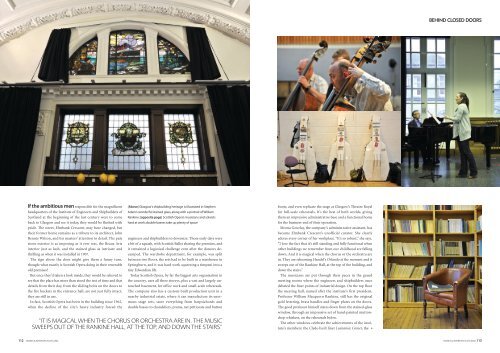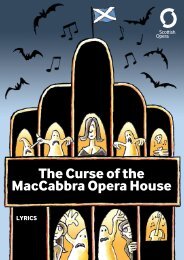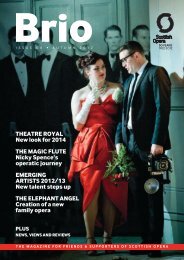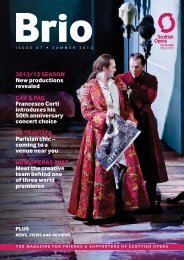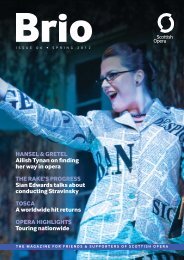Hitting the - Scottish Opera
Hitting the - Scottish Opera
Hitting the - Scottish Opera
You also want an ePaper? Increase the reach of your titles
YUMPU automatically turns print PDFs into web optimized ePapers that Google loves.
BEHIND CLOSED DOORSIf <strong>the</strong> ambitious men responsible for <strong>the</strong> magnificen<strong>the</strong>adquarters of <strong>the</strong> Institute of Engineers and Shipbuilders ofScotland at <strong>the</strong> beginning of <strong>the</strong> last century were to comeback to Glasgow and see it today, <strong>the</strong>y would be flushed withpride. The street, Elmbank Crescent, may have changed, but<strong>the</strong>ir former home remains as a tribute to its architect, JohnBennie Wilson, and his masters’ attention to detail. The palestone exterior is as imposing as it ever was, <strong>the</strong> Beaux Artsinterior just as lush, and <strong>the</strong> stained glass as intricate andthrilling as when it was installed in 1907.The sign above <strong>the</strong> door might give <strong>the</strong>m a funny turn,though: what exactly is <strong>Scottish</strong> <strong>Opera</strong> doing in <strong>the</strong>ir venerableold premises?But once <strong>the</strong>y’d taken a look inside, <strong>the</strong>y would be relieved tosee that <strong>the</strong> place has more than stood <strong>the</strong> test of time and thatdetails from <strong>the</strong>ir day, from <strong>the</strong> sliding bolts on <strong>the</strong> doors to<strong>the</strong> fire buckets in <strong>the</strong> entrance hall, are not just fully intact,<strong>the</strong>y are still in use.In fact, <strong>Scottish</strong> <strong>Opera</strong> has been in <strong>the</strong> building since 1962,when <strong>the</strong> decline of <strong>the</strong> city’s heavy industry forced <strong>the</strong>[Above] Glasgow’s shipbuilding heritage is illustrated in StephenAdam’s wonderful stained glass, along with a portrait of WilliamRankine; [opposite page] <strong>Scottish</strong> <strong>Opera</strong>’s musicians and soloistshard at work; double basses take up plenty of spaceengineers and shipbuilders to downsize. Those early days werea bit of a squash, with <strong>Scottish</strong> Ballet sharing <strong>the</strong> premises, andit remained a logistical challenge even after <strong>the</strong> dancers de -camped. The wardrobe department, for example, was splitbetween two floors, <strong>the</strong> sets had to be built in a warehouse inSpringburn, and it was hard work squeezing a timpani into atiny Edwardian lift.Today <strong>Scottish</strong> <strong>Opera</strong>, by far <strong>the</strong> biggest arts organisation in<strong>the</strong> country, uses all three storeys, plus a vast and largely un -touched basement, for office work and small-scale rehearsals.The company also has a custom-built production unit in anearby industrial estate, where it can manufacture its enor -mous stage sets, store everything from harpsichords anddouble basses to chandeliers, prams, net petticoats and button“IT IS MAGICAL WHEN THE CHORUS OR ORCHESTRA ARE IN. THE MUSICSWEEPS OUT OF THE RANKINE HALL, AT THE TOP, AND DOWN THE STAIRS”boots, and even replicate <strong>the</strong> stage at Glasgow’s Theatre Royalfor full-scale rehearsals. It’s <strong>the</strong> best of both worlds, giving<strong>the</strong>m an impressive administrative base and a functional homefor <strong>the</strong> business-end of <strong>the</strong>ir operation.Morna Gourlay, <strong>the</strong> company’s administrative assistant, hasbecome Elmbank Crescent’s unofficial curator. She clearlyadores every corner of her workplace. “It’s so robust,” she says.“I love <strong>the</strong> fact that it’s still standing and fully functional wheno<strong>the</strong>r buildings we remember from our childhood are fallingdown. And it is magical when <strong>the</strong> chorus or <strong>the</strong> orchestra arein. They are rehearsing Handel’s Orlando at <strong>the</strong> moment and itsweeps out of <strong>the</strong> Rankine Hall, at <strong>the</strong> top of <strong>the</strong> building, anddown <strong>the</strong> stairs.”The musicians are put through <strong>the</strong>ir paces in <strong>the</strong> grandmeeting rooms where <strong>the</strong> engineers and shipbuilders oncedebated <strong>the</strong> finer points of industrial design. On <strong>the</strong> top floor<strong>the</strong> meeting hall, named after <strong>the</strong> institute’s first president,Professor William Macquorn Rankine, still has <strong>the</strong> originalgold lettering, brass handles and finger plates on <strong>the</strong> doors.The good professor himself stares down from <strong>the</strong> stained-glasswindow, through an impressive set of hand-painted muttonchopwhiskers, on <strong>the</strong> rehearsals below.The o<strong>the</strong>r windows celebrate <strong>the</strong> achievements of <strong>the</strong> insti -tute’s members: <strong>the</strong> Clyde-built liner Lusitania; Comet, <strong>the</strong>112 HOMES & INTERIORS SCOTLANDHOMES & INTERIORS SCOTLAND 113


